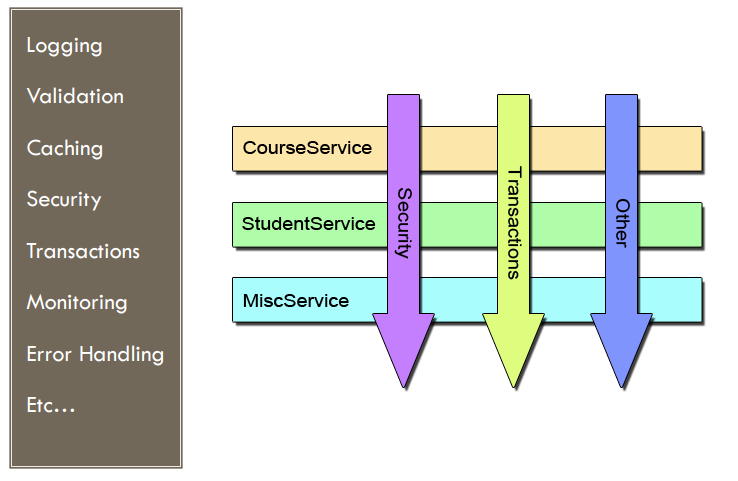AOP
动态代理
- 基于接口 JDK
- 基于子类
public class Main {
public static void main(String[] args) {
Bean bean = (Bean) Enhancer.create(Bean.class, new MethodInterceptor() {
private Bean bean = new Bean();
@Override
public Object intercept(Object o, Method method, Object[] objects, MethodProxy methodProxy) throws Throwable {
System.out.println(method);
return method.invoke(bean,objects);
}
});
bean.run();
}
}
class Bean{
public void run(){
System.out.println("bean run");
}
}
AOP简介

AOP术语:
通知(Advice):所谓通知是指拦截到Joinpoint之后所要做的事情就是通知
- 前置通知(before):执行前执行
- 后置通知(after):执行后执行
- 返回通知(after returning)
- 异常通知(after throwing)
- 环绕通知(around)
使用xml时,后置通知与返回通知以及异常通知的执行顺序取决于配置顺序
- 连接点(Joinpoint):所谓连接点是指那些被拦截到的点。在spring中,这些点指的是方法,因为spring只支持方法类型的连接点。
- 切点(Pointcut):所谓切入点是指我们要对哪些Joinpoint进行拦截的定义。
- 切面(Aspect):是切入点和通知(引介)的结合。
- 引入(Introduction):引介是一种特殊的通知在不修改类代码的前提下, Introduction可以在运行期为类动态地添加一些方法或Field。
- 织入(Weaving):是指把增强应用到目标对象来创建新的代理对象的过程。
编写切点
- AspectJ指示器
Spring借助AspectJ的切点表达式语言来定义切面
| AspectJ指示器 | 描述 |
|---|---|
| arg() | 限制连接点匹配参数为指定类型的执行方法 |
| @args() | 限制连接点匹配参数由指定注解标注的执行方法 |
| execution() | 用于匹配是连接点的执行方法 |
| this() | 限制连接点匹配AOP代理的Bean引用为指定类型的类 |
| target() | 限制连接点匹配目标对象为指定类型的类 |
| @target () | 限制连接点匹配特定的执行对象,这些对象对应的类要具备指定类型的注解 |
| within() | 限制连接点匹配指定的类型 |
| @within() | 限制连接点匹配指定注解所标注的类型( 当使用Spring AOP时,方法定义在由指定的注解所标注的类里) |
| @annotation | 限制匹配带有指定注解连接点 |
- 一个简单的切点实例
execution(* wang.ismy.spring.service.Service.doSth(..))
execution
execution(*com.sample.service.impl..*.*(..)) 解释如下:
| 符号 | 含义 |
|---|---|
| execution () | 表达式的主体 |
| 第一个"*"符号 | 表示返回值的类型任意 |
| com.sample.service.impl | AOP所切的服务的包名,即,我们的业务部分 |
| 包名后面的"." | 表示当前包及子包 |
| 第二个"*" | 表示类名,*即所有类。此处可以自定义,下文有举例 |
| .*(..) | 表示任何方法名,括号表示参数,两个点表示任何参数类型 |
创建切面
@Aspect
@Component
@Slf4j
public class ErrorPageAspect {
@Pointcut("@annotation(wang.ismy.zbq.annotations.ErrorPage)")
public void pointCut(){}
@Around("pointCut()")
public Object around(ProceedingJoinPoint joinPoint){
try {
return joinPoint.proceed();
} catch (Throwable throwable) {
ModelAndView modelAndView = new ModelAndView();
modelAndView.setViewName("error");
modelAndView.addObject("error",throwable.getMessage());
return modelAndView;
}
}
}
使用xml
<?xml version="1.0" encoding="UTF-8"?>
<beans xmlns="http://www.springframework.org/schema/beans"
xmlns:xsi="http://www.w3.org/2001/XMLSchema-instance"
xmlns:aop="http://www.springframework.org/schema/aop"
xsi:schemaLocation="http://www.springframework.org/schema/beans
https://www.springframework.org/schema/beans/spring-beans.xsd
http://www.springframework.org/schema/aop
https://www.springframework.org/schema/aop/spring-aop.xsd">
<aop:config>
<!--配置切面-->
<aop:aspect id="loggerAdvice" ref="logger">
<aop:around method="log" pointcut="execution(* wang.ismy.spring.service.Service.doSth(..))"/>
</aop:aspect>
</aop:config>
<bean class="wang.ismy.spring.service.impl.ServiceImpl"/>
<bean id="logger" class="wang.ismy.spring.Logger"/>
</beans>
AOP 原理
AbstractAutoProxyCreator 实现了BeanPostProcessor
通过在Bean 实例化后,通过动态代理的方式 createProxy 对 Bean进行一层包裹 返回代理完成后的Bean
AopProxy 目前Spring 有2种方式 ...